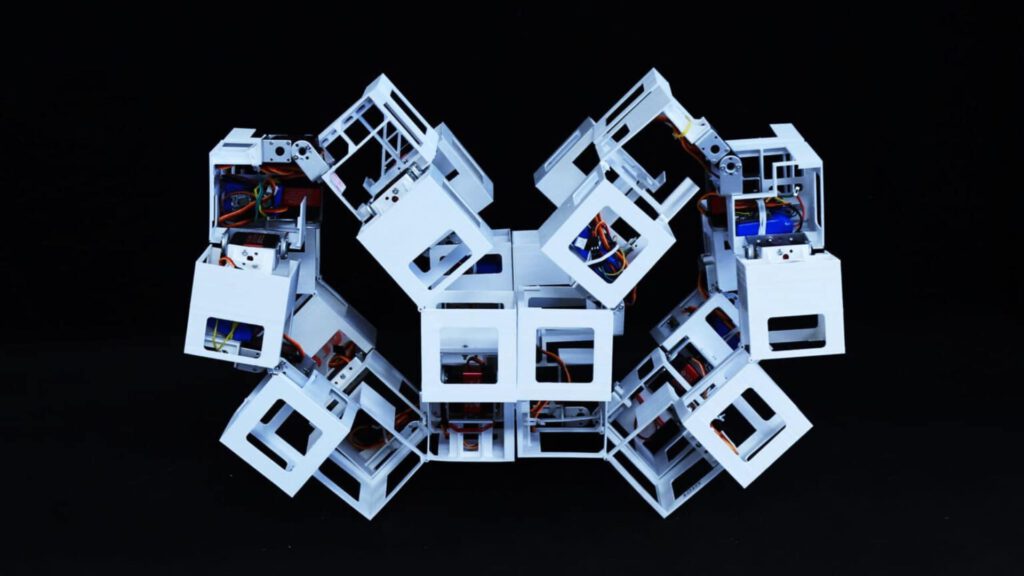Inspired by origami, the Japanese art of paper folding, researchers have developed a shape-changing “transformer” robot.
The North Carolina State University (NC State) team’s method enables a single plastic cubic structure to transform into more than 1,000 different shapes using just three active motors.
Engineers believe the discovery could lead to artificial systems that can change shape to withstand loads, including adaptive robotic structures suitable for use in space.
“Here, we used plastic cubes to create a transforming robot, incorporating hierarchical concepts observed in nature, such as layered muscle fibers,” Ji Yin, an associate professor of mechanical and aerospace engineering at North Carolina State University and co-corresponding author of the study, said in a statement.
For biological or artificial systems to be multifunctional and adapt to different situations, they need to have versatile shape-changing capabilities, for example, a mimetic octopus can rapidly transform into different shapes.
Strategies such as beams, origami structures, and reconfigurable robots enable shape transformation of artificial systems but are not without challenges, including complex actuation and limited practical utility.
Despite great advances, artificial systems have yet to match the versatility and efficiency of living organisms, according to the researchers. The key to versatility is mobility and degrees of freedom (DOF).
Traditional rigid origami structures only have one degree of freedom (DOF), limiting shape changes. The team highlights that modular origami meta-structures are an example of recent progress, where polyhedral-shaped modules enable high mobility, albeit requiring complex actuation systems.
The group proposed a hierarchical structure of spatial closed-loop processes as a solution to these problems. By replacing inflexible connections with flexible multi-layer structures, these systems enable a wide range of reconfigurable megastructures with infinite design options that balance operational efficiency and versatility.
A shape-shifting robot for multiple purposes
The aim of this project is to minimise the number of actuators powering the shape change, enabling shapes for a wide variety of applications.
Researchers at North Carolina State University used a 3D printer to assemble 36 hollow plastic cubes with rotating hinges, some of which are secured by metal pins and others which are actuated wirelessly by motors.
Using just three active motors, the researchers were able to rearrange the cube into over 1,000 different configurations, including skyscrapers, bridge-like structures, tunnel-like structures, and more.
Transformer bots that aren’t tethered to cables can move forward, backward, and sideways without the need for legs, simply by manipulating the structure’s shape changes.
The team says the robot can change shape fairly quickly, from flat or fully open to a large, box-like cube or fully closed, and it can lift three times its own weight.
The researchers then aim to further improve the Transformer bot, with the current goal being to create a stronger structure that can withstand greater loads.
“We envision these could be used as deployable, configurable space robots or habitats. Because they’re modular, they can be sent flat into space, assembled into a shelter or habitat, and then disassembled,” said Antonio Di Lalo, a postdoctoral researcher at North Carolina State University and co-first author of the paper.
Details of the team’s research were published in the journal Nature.
Newsletter
Blueprint Daily
Get the latest news in engineering, technology, space and science with The Blueprint.
About the Editor
Jijo Marail Jijo is an automotive and business journalist based in India. He holds a BA (Hons) in History from St. Stephen’s College, University of Delhi and a Postgraduate Diploma in Journalism from the Indian Institute of Mass Communication, Delhi. He has worked for news agencies, national newspapers and automotive magazines. In his spare time, he enjoys off-roading, political debates, travelling and teaching languages.

